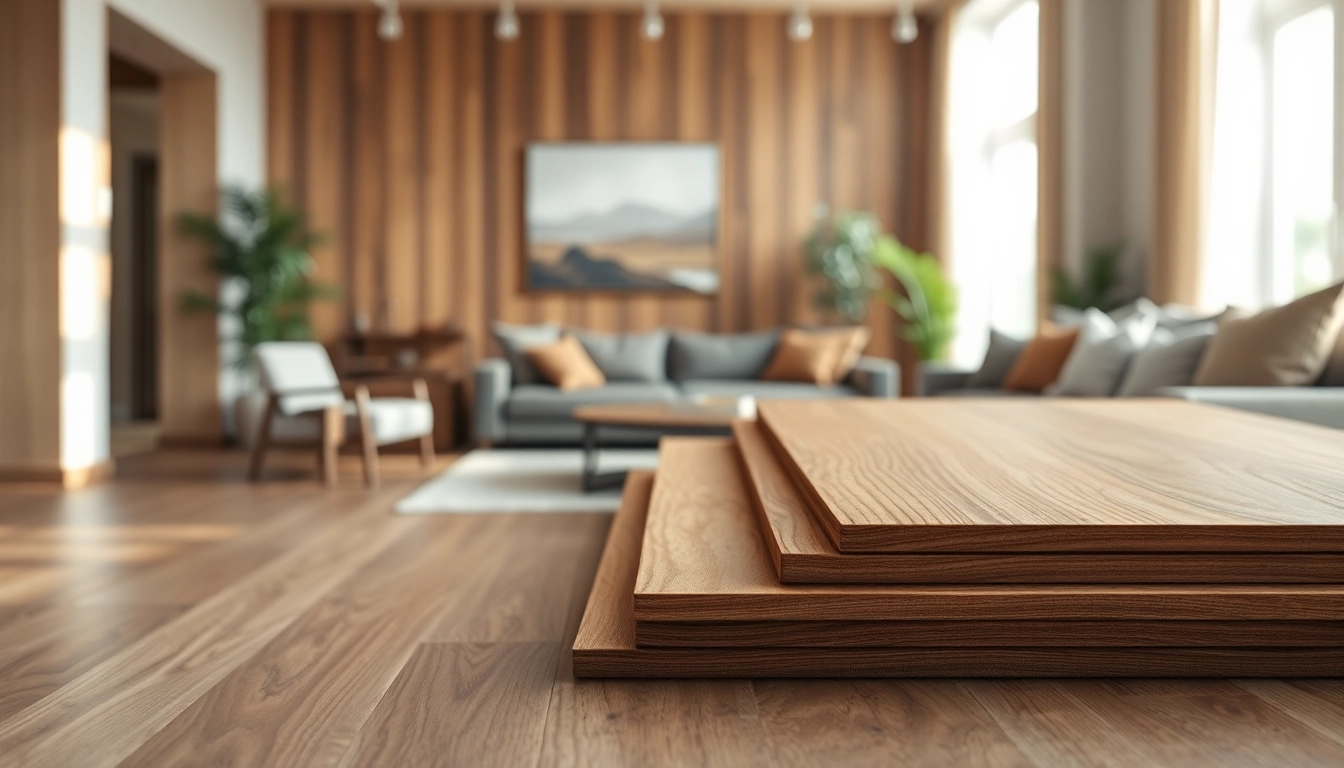What Are Wood Paneling Sheets?
Definition and Overview
Wood paneling sheets are versatile building materials crafted from various types of wood that are cut into thin panels. These panels are designed for interior and exterior applications, serving the dual purpose of enhancing aesthetics while also providing functional benefits. The appeal of wood paneling sheets lies in their ability to bring a natural warmth to spaces, evoking a sense of tranquility and comfort. Utilizing wood paneling sheets can transform dull walls into visually dynamic surfaces, adding depth and texture to any room.
Types of Wood Paneling Sheets
Understanding the various types of wood paneling sheets is crucial for making an informed selection for your project. These can be categorized primarily into two groups: solid wood panels and engineered wood panels.
- Solid Wood Panels: These are made from a single piece of wood, showcasing the unique grain patterns and characteristics natural to the wood species. Common types include oak, maple, cherry, and pine. They offer a robust feel and durability but can be more expensive and require careful maintenance.
- Engineered Wood Panels: Composed of multiple layers of wood veneers or fibers, engineered panels provide stability and resistance to warping. They can mimic the appearance of solid wood while being more affordable. Common types include plywood and MDF (medium-density fiberboard).
Common Uses and Applications
Wood paneling sheets are employed in a variety of contexts due to their aesthetic and functional flexibility. Common applications include:
- Residential Interiors: Living rooms, dining areas, and bedroom walls, where they are often used to create accent walls.
- Commercial Spaces: Offices, hotels, and restaurants utilize wood paneling for branding and creating inviting atmospheres.
- Acoustic Treatment: Wood paneling sheets can help reduce noise levels in spaces like studios and conference rooms.
- Ceilings and Floors: While less common, wood paneling can also be applied to ceilings or as flooring, providing cohesive design elements through a space.
Benefits of Choosing Wood Paneling Sheets
Enhanced Aesthetic Appeal
One of the primary benefits of wood paneling sheets is their profound ability to enhance the aesthetic ambiance of a space. The natural beauty of wood introduces warmth and richness, making it a popular choice in design. By selecting different woods and finishes, one can create looks that range from rustic and traditional to sleek and modern.
Insulation and Acoustic Properties
Wood inherently has insulating properties, offering thermal benefits that can lead to improved energy efficiency in the home or building. Additionally, wood paneling sheets can absorb sound, enhancing the acoustic qualities of a room. This is particularly valuable in spaces designed for conversations, meetings, or entertainment, ensuring muted noise levels and comfortable environments.
Durability and Maintenance
Wood paneling sheets are known for their durability, especially when properly treated and maintained. They are less prone to damage compared to other wall surfaces and can last for many years. Basic maintenance involves cleaning and refinishing, ensuring that they remain in great condition over time. In contrast to wallpaper that may peel or fade, wood panels offer a timeless aesthetic and longevity.
How to Select the Right Wood Paneling Sheets
Assessing Your Design Needs
Before selecting wood paneling sheets, it’s essential to clearly define your design needs. Consider the overall aesthetics, the atmosphere you wish to create, and the functionality you require. For instance, in a cozy reading nook, a warm-toned wood may foster comfort, while a cooler finish could be more appropriate for a modern office.
Understanding Wood Varieties and Finishes
Different wood species offer varying properties and aesthetics. Hardwoods like oak and maple are more resistant to wear and damage. Additionally, finishes significantly impact the final look – matte finishes lend a more organic aesthetic while glossy ones can convey sophistication. Match your choice of wood and finish to the existing décor for a harmonious look.
Budget Considerations
Budget plays a significant role in your selection process. Solid wood panels generally cost more than engineered materials. Assess your budget, including costs for installation, to determine the best option that doesn’t compromise on quality. Planning for the long-term value can help justify an investment in higher-quality panels that will last longer and enhance your space.
Installation Guide for Wood Paneling Sheets
Preparation and Tools Required
Successful installation of wood paneling sheets begins with adequate preparation. Ensure that your workspace is clean and that you have the right tools on hand. Essential tools include:
- Level
- Stud finder
- Measuring tape
- Circular saw or table saw
- Nail gun or hammer
- Adhesive (if applicable)
- Safety goggles
Prepare the wall surface by patching any holes or imperfections, and ensure it is dry and clean. Using a level, mark lines where the paneling should be installed, making sure to locate studs for secure fastening.
Step-by-Step Installation Process
1. Measure and Cut: Accurately measure the height and width of your walls. Cut the panels to size using a circular or table saw, taking care to account for any fittings or features in the wall.
2. Anchor the First Panel: Start installing the first panel at one corner of the wall. Use a level to ensure it is straight, and fasten it securely using either a nail gun or adhesive, depending on your installation choice.
3. Continue the Process: Overlapping the edges as necessary, continue installing additional panels. It’s important to stagger seams for a more natural aesthetic.
4. Finishing Touches: Once all panels are installed, you may choose to stain or paint them to meet your desired finish. Apply caulk to gaps where necessary, ensuring a seamless look.
Tips for DIY vs. Hiring Professionals
While many homeowners might choose to install wood paneling sheets as a DIY project, it’s essential to weigh your skills and tools against the complexity of the installation. If you’re unsure or if the installation involves intricate design specifications, hiring a professional can save time, ensure quality, and alleviate the potential for costly mistakes.
Care and Maintenance of Wood Paneling Sheets
Cleaning Techniques and Products
Caring for wood paneling sheets involves regular cleaning to maintain their appearance. Use a soft, damp cloth to dust them, and avoid harsh chemicals that can damage the finish. For deeper cleaning, consider a mild soap solution or specialized wood cleaner suitable for the type of finish applied to your panels.
Repairing Damages and Enhancements
Minor scratches and dents can often be repaired by sanding the affected area and refinishing it to match the surrounding surface. For more significant damage, replacing the affected panel may be necessary. Enhancements, such as protective finishes or coatings, can extend the life of wood paneling sheets and enhance their visual appeal.
Seasonal Maintenance Tips
Wood is sensitive to humidity and temperature fluctuations. During seasonal changes, adjust the heating and cooling in your space to maintain a stable environment. Consider using a humidifier during dry months to prevent wood from cracking and splitting. Inspect your paneling periodically for signs of wear or damage, addressing them promptly to prolong their lifespan.



